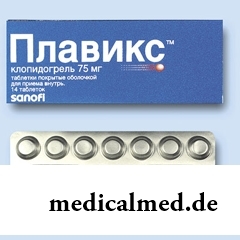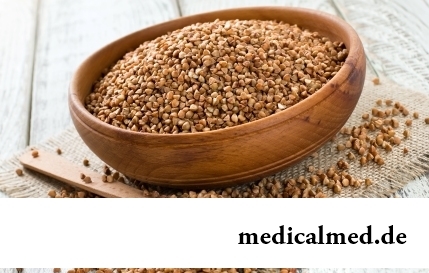





Плавикс
Application instruction:
 Плавикс – an antiagregant.
Плавикс – an antiagregant.
Form of release and structure
Dosage form – tablets, film coated: pink color, on round slightly biconvex tablets the engraving "is applied to I 171" on one party and "75" – on another, on oblong tablets – number "1332" on one party and "300" – on another (on 75 mg: on 7, 10 or 14 pieces in the blister, in a cardboard pack 1, 2 or 3 blisters; on 300 mg: on 10 pieces in the blister, in a cardboard pack 1 or 3 blisters).
– klopidogret active ingredient of Plaviks hydrosulphate (form II), in 1 tablet – 97,875 mg (it is equivalent to the content of 75 mg of klopidogrel) or 391,5 mg (it is equivalent to the content of 300 mg of klopidogrel).
Auxiliary components: a macrogoal 6000, Mannitolum, cellulose microcrystallic (with low the content of water, 90 microns), the castor oil hydrogenated the hypro rod low-replaced.
Structure of a film cover: wax of karnaubskiya, опадрай pink (triacetin, lactoses monohydrate, titanium dioxide (E171), dye ferrous oxide red (E172), gipromelloz).
Indications to use
Plaviks's use is shown for prevention of aterotrombotichesky complications at the following pathologies:
- Myocardial infarction in the period of a disease from several days to 35 days, an ischemic stroke (with prescription from 7 days to 6 months), the diagnosed occlusal disease of peripheral arteries;
- Myocardial infarction without tooth Q or unstable stenocardia (an acute coronary syndrome without raising of a segment of ST), including when performing stenting at transdermal coronary intervention (in combination with acetylsalicylic acid);
- Acute myocardial infarction (an acute coronary syndrome with raising of a segment of ST) at medicamentous therapy and a possibility of a thrombolysis (in combination with acetylsalicylic acid).
Besides, drug is appointed for prevention of tromboembolic and aterotrombotichesky episodes (including a stroke) at patients with a ciliary arrhythmia (fibrillation of auricles) which cannot accept indirect anticoagulants, have at least one risk factor of development of vascular complications and insignificant probability of development of bleeding (in combination with acetylsalicylic acid).
Tablets with the maintenance of a klopidogrel of 300 mg are intended only for reception as a load dose at treatment of an acute coronary syndrome.
Contraindications
- Age up to 18 years;
- Acute bleeding, including intracraneal hemorrhage, round ulcer;
- The expressed liver failure;
- Intolerance of a galactose, syndrome of glyukozo-galaktozny malabsorption, deficit of lactase;
- Period of pregnancy and breastfeeding;
- Hypersensitivity to a klopidogrel and other components of drug.
With care it is recommended to appoint Plaviks the patient with a moderate liver failure (because of risk of bleeding), a renal failure, predisposed to development of bleedings by pathologies (including intraocular, gastrointestinal), the instruction in the anamnesis on hematologic and allergic reactions on тиклопидин, prazugret also other thienopyridines.
Extra care should be observed at the accompanying therapy by the medicines capable to cause damages of a mucous membrane of digestive tract (non-steroidal anti-inflammatory drugs (NPVS) and drugs of acetylsalicylic acid (ASK) concern to them), at injuries, surgical intervention and other morbid conditions with the increased risk of development of bleedings, at simultaneous use of inhibitors of a glycoprotein of IIb/IIIa, warfarin, heparin, NPVS (including the selection TsOG-2 inhibitors, selective serotonin reuptake inhibitors), of ASK, at low activity of an isoenzyme of CYP2C19, after an ischemic stroke or passing disturbance of cerebral circulation postponed recently.
Route of administration and dosage
Плавикс accept orally, irrespective of meal.
The recommended dosing for adults and patients of advanced age with normal activity of an isoenzyme of CYP2C19:
- Ischemic stroke, myocardial infarction, the diagnosed occlusal disease of peripheral arteries: on 75 mg of 1 times a day;
- Unstable stenocardia, myocardial infarction without Q tooth (an acute coronary syndrome without raising of a segment of ST): an initial load dose – 300 mg once, then on 75 mg of 1 times a day with a concomitant use of acetylsalicylic acid in a dose of 75-325 mg a day. As reception of higher doses of acetylsalicylic acid is accompanied by risk of bleedings, the patient should appoint up to 100 mg of acetylsalicylic acid a day. Treatment duration – 3-12 months, depending on individual dynamics of treatment;
- Acute myocardial infarction with raising of a segment of ST (an acute coronary syndrome with raising of a segment of ST): an initial load dose – 300 mg once, in combination with acetylsalicylic acid and trombolitika or without them, then on 75 mg of 1 times a day. The patient 75 years are aged more senior it is recommended to carry out therapy without load dose. The combined treatment should be begun with the moment of emergence of the first symptoms of a disease and to continue within 4 weeks. Efficiency of longer therapy klopidogrely in combination with acetylsalicylic acid is not established;
- Ciliary arrhythmia (fibrillation of auricles): 75 mg of 1 times a day in a combination from 75-100 mg of acetylsalicylic acid.
Плавикс it is necessary to accept always in at one time days. In case of delay of reception of the next dose till 12 o'clock the pill should be taken immediately, and following – at the scheduled time. As the double dose of drug cannot be accepted if delay made more than 12 hours, the patient has to accept the following dose in usual time.
The optimum mode of dosing of a klopidogrel for patients with genetically caused reduced activity of an isoenzyme of CYP2C19 is not set therefore for this category of patients the usual dose of drug is recommended to be doubled, it will allow to increase antiagregantny action of a klopidogrel. A load dose – 600 mg, then on 150 mg of 1 times a day daily.
Dose adjustment for patients of advanced age is not required.
Side effects
Clinically significant side effects established at conduct of clinical trials:
- Hemorrhagic disturbances: often – a purpura or bruises, nasal bleeding; seldom – hematomas, a hamaturia, eye hemorrhages (conjunctival are more often); perhaps (including with a lethal outcome) – intracraneal hemorrhage, a hemorrhagic stroke, gastrointestinal bleedings, not cerebral and cerebral bleedings;
- System of a hemopoiesis: perhaps – aplastic anemia, a neutropenia, thrombocytopenia; infrequently – a leukopenia, reduction in the amount of thrombocytes in peripheral blood, an eosinophilia, decrease in neutrophils in peripheral blood;
- Alimentary system: often – diarrhea, an abdominal pain, dyspepsia; infrequently – abdominal distention, nausea, gastritis, vomiting, a lock, stomach ulcer and/or a duodenum;
- Nervous system: infrequently – a headache, paresthesia, dizziness; seldom – вертиго;
- Dermatological reactions: infrequently – a skin itch, rash;
- Coagulant system of blood: infrequently – increase in the period of bleeding.
Post-marketing data of the undesirable phenomena from Plaviks's use:
- Hemorrhagic disturbances: frequency is unknown – serious bleedings (hypodermic, skeletal and muscular, eye hemorrhages (conjunctival, in a retina and tissues of an eye)), pulmonary bleeding, a pneumorrhagia, nasal bleeding are more often, than a hamaturia and bleeding from postoperative wounds, intracraneal hemorrhages, gastrointestinal bleedings, retroperitoneal hemorrhages (including with a lethal outcome);
- System of a hemopoiesis: frequency is unknown – an agranulocytosis, aplastic anemia or a pancytopenia, a granulocytopenia, the acquired hemophilia And, a trombotichesky Werlhof's disease;
- Nervous system: frequency is unknown – disturbances of flavoring perception;
- Mental disturbances: frequency is unknown – hallucinations, confusion of consciousness;
- Respiratory system: frequency is unknown – a bronchospasm, eosinophilic pneumonia, intersticial pneumonia;
- Cardiovascular system: frequency is unknown – a lowering of arterial pressure, a vasculitis;
- Alimentary system: frequency is unknown – colitis (including ulcer colitis, lymphocytic colitis), stomatitis, pancreatitis, an acute liver failure, hepatitis (noninfectious);
- Musculoskeletal system: frequency is unknown – arthritis, an arthralgia, a mialgiya;
- Allergic reactions: frequency is unknown – a serum disease, anaphylactoid reactions, cross hematologic and allergic reactions with other thienopyridines (including prazugret, тиклопидин);
- Dermatological reactions: frequency is unknown – a skin itch, makulopapulezny, exfoliative or erythematic rash, a small tortoiseshell, a Quincke's disease, a syndrome of medicinal hypersensitivity, violent dermatitis (Stephens-Johnson's syndrome, a mnogoformny erythema, a toxic epidermal necrolysis), medicinal rash with system DRESS syndrome and an eosinophilia, flat deprive, eczema;
- Urinary system: frequency is unknown – a glomerulonephritis;
- Laboratory researches: frequency is unknown – disturbance of indicators of function of a liver, increase in level of concentration of creatinine in blood;
- General frustration: frequency is unknown – fever.
Special instructions
Plaviks's use should be accompanied with careful control of possible emergence of symptoms of bleeding (including hidden), especially during the first weeks of treatment, and also after carrying out surgeries and cardiological invasive procedures.
At emergence of clinical symptoms of bleeding it is required to carry out urgently the general blood test, to define indicators of functional activity of thrombocytes and their quantity, the activated partial tromboplastinovy time, other necessary researches.
As drug extends a bleeding time, extra care is recommended to be shown at treatment of patients with the increased risk of development of bleeding, especially at diseases with predisposition to development of bleedings.
The patient has to be informed on need of the immediate address to the attending physician at emergence unusual on duration or localization of bleeding.
Use of any new medicine can be begun only after consultation of the doctor.
Reception of a klopidogrel should be cancelled in 5-7 days prior to carrying out the planned surgery which is not demanding antithrombocytic effect.
Before operation, at visit of the stomatologist the patient has to report to the doctor about Plaviks's reception.
Against the background of use of drug there is a risk of development of a trombotichesky Werlhof's disease – the life-threatening state demanding urgent measures including a plasma exchange.
The combination therapy klopidogrely and ASK at patients after recently had passing disturbance of cerebral circulation or a stroke raises rice of development of big bleedings therefore it should be seen off with care and at the confirmed potential advantage for the patient.
Use of a klopidogrel in the recommended doses with low activity of an isoenzyme of CYP2C19 at transdermal coronary intervention or an acute coronary syndrome can cause higher frequency of development of cardiovascular complications in patients.
At purpose of drug it is necessary to study carefully the anamnesis of the patient regarding the available hematologic and/or allergic reactions on тиклопидин, prazugret also other thienopyridines as there is a risk of cross moderate and heavy allergic and/or hematologic reactions between thienopyridines.
At the confirmed diagnosis of the acquired hemophilia use of a klopidogrel should be stopped.
During therapy control of functional activity of a liver is required, in case of severe damages of a liver it is necessary to consider a possibility of development of hemorrhagic diathesis.
Use of a klopidogrel at an acute stroke with prescription to 7 days is not recommended.
Плавикс does not exert impact on ability of the patient to control of vehicles and mechanisms.
Medicinal interaction
For the purpose of prevention of development of undesirable side effects during Plaviks's use, it is recommended to get advice of the attending physician before reception of any medicines.
Terms and storage conditions
To protect from children.
To store at a temperature up to 30 °C.
Period of validity – 3 years.
Name of drug
Price
Drugstore
Плавикс тбл п / about 75 mg No. 28, Sanofi-Winthrop
2719 rub.
 Network of the Moscow drugstores of IFC
Network of the Moscow drugstores of IFCThe liver is the heaviest body in our body. Its average weight makes 1,5 kg.

Traveling all over the world, many try to try the most exotic dishes of national cuisines. Exists even so-called died away...
Section: Articles about health
The kid who was recently born is surrounded with love of adult family members and their cares without which the baby cannot exist. Some parents consider that gentle attachment and caress are quite enough that the child correctly developed and was happy...
Section: Articles about health
Bulimia and anorexia, are heavy deviations of a feeding behavior, become a cause of death of patients much more often than all other nervous breakdowns combined. In 60% of cases two illnesses accompany each other: patients feel horror before danger of set of excess weight and try to refuse as often as possible food, but periodically suffer from attacks of sudden hunger and an uncontrollable overeating. Each patient with anorexia and bulimia needs the help qualified пс...
Section: Articles about health
The mankind knows that some toxins at intake in the minimum quantities have therapeutic effect...
Section: Articles about health
Practically each person is familiar with the annoying, pulling, unscrewing pains caused by overcooling of muscles of a back. In certain cases inflammatory process is not limited to discomfort, being followed by emergence of hypostasis, consolidations, increase температ...
Section: Articles about health
All the known slogan "Protect Men!" arose not from scratch. In a sense, the nature created men much less adapted for vital disorders, than it seems at first sight. Statistically, men are ill more often, than women, have the majority of illnesses heavier and earlier die. The situation is aggravated with the fact that our fathers, husbands, brothers and sons are not always inclined to care for the health. Partly it happens because of unwillingness of t...
Section: Articles about health
History of cultivation of a buckwheat contains more than five thousand years. Grain which is received from this plant is used for пригото...
Section: Articles about health
The trophic ulcer is not an independent disease. This heavy complication arising owing to a thermal injury (a burn or a frostbite), chronic pathologies of arteries or veins of the lower extremities, a diabetes mellitus, and also some defeats of a soyeda...
Section: Articles about health
Good appetite was always considered as a sign of good health. The correct operation of the mechanism which is responsible for the need for nutrients and receiving pleasure from process of its satisfaction demonstrates that the organism functions without special deviations. On the other hand, appetite of the person is not a constant. It depends on the culture of food, flavoring addictions imparted since the childhood which can change during life, weather, mood and many д more than once...
Section: Articles about health
Mushrooms - the surprising inhabitants of our planet having a set of wonderful qualities. Thanks to one of them, a mold mushroom of Penici...
Section: Articles about health
Summer in the heat. Many are going to spend vacation abroad. Travelers the tender seas, rest on beaches wait, for sightseeing, campaigns on natural and cultural reserves. But, unfortunately, on vacation also problems about health can wait for us...
Section: Articles about health
The immunity role in growth of the child is invaluable. The proteins-immunoglobulins produced by immune system preserve the child against the diseases capable − owing to an organism weak still − to serve as a stressful factor, to become the reason of many complications and delays in development of the kid. If the immune system weakened, health of the child is under direct threat and needs active actions for strengthening of protective forces of an organism − preferably non-drug....
Section: Articles about health
The main role in development of a peptic ulcer of a stomach and duodenum the bacterium Helikobakter plays pilor. Activity and Wuxi...
Section: Articles about health
It would seem, about it there can be no disagreements: water is necessary for a human body for normal life activity, and about how and when it should be drunk, all know. It turned out that the situation is not absolutely so: for many years occur ве...
Section: Articles about health
The way of life of people promptly changes from year to year: if about ten years ago the personal computer was not in each family, then today already very few people do without this device. Certainly, and children master the computer at full speed: they not only play on it games, but also study, and write school works, and search for necessary information....
Section: Articles about health
According to doctors, more than a half of men of 25-50 years suffer from frustration of the urinogenital sphere, but sees a doctor from them меньшинс...
Section: Articles about health
To look healthy and means well-groomed not only to be pleasant to people around, but also to feel strong, sure and taken place. Specialists in the field of cosmetology quite often note that whether not all women are able to look after skin...
Section: Articles about health
The saying "the rich do not know how the other half lives" is known to all. In a broad sense it is that we can not always understand the person whose features of a state are unknown to us. If with physiological characters of diseases the situation is more or less clearly (having noticed them, we realize that to the person nezdorovitsya), then with symptoms of the illnesses affecting the mental sphere everything is much more difficult. Not absolutely usual behavior is quite often perceived surrounding as a ridiculous eccentricity, or that much ху...
Section: Articles about health
Doctors claim that the people not so familiar with a dorsodynia occur among adult Russians very seldom. At the same time подавляющ...
Section: Articles about health
With age in a human body harmful substances collect. We receive them with food and water, at inhalation of the contaminated air, reception of medicines, use of household chemicals and cosmetics. A considerable part of toxins accumulates in a liver, osnovno...
Section: Articles about health
Any of us is not insured from a heavy illness of the loved one. Happens and so that someone from family members becomes the bed patient, and remains in such state for a long time. It extremely suppresses both the most injured, and all its house which life considerably changes....
Section: Articles about health
Practice of use of table salt in the therapeutic purposes contains not one century. Appl are considered especially effective...
Section: Articles about health
Health and attractiveness - eternal values, pursuing which people often use the most unusual ingredients and technicians. Let's consider 11 most exotic and sometimes not most pleasant Spa procedures to which the person in a pursuit for beauty agrees...
Section: Articles about health
About 20% of the population of our planet have a hypertension (permanent increase in arterial pressure). This disease has an adverse effect on the standard of living, reduces working capacity, and in the absence of systematic treatment threatens with such complications as a myocardial infarction, a stroke and other heavy illnesses which can result in disability or sudden death. Most of patients for maintenance of pressure at more or less acceptable level accept appointed doctors лекарст...
Section: Articles about health
Each person knows that fervescence is an illness sign. However about existence of diseases can to suite...
Section: Articles about health
The medicine promptly develops, and the fact that else quite recently it seemed by miracle can now. We are not surprised any more to the fact that people with artificial joints and extremities can play sports, organ transplantation became a routine, and the latest cancer medicine п...
Section: Articles about health
The words "disease" and "patient" not without reason come from one root – "pain". As a rule, symptoms of illnesses thoroughly spoil to patients life. However from this rule there are exceptions. Some diseases are shown by signs which can cause even positive emotions. It is a pity only that the majority of such illnesses are heavy and incurable....
Section: Articles about health

